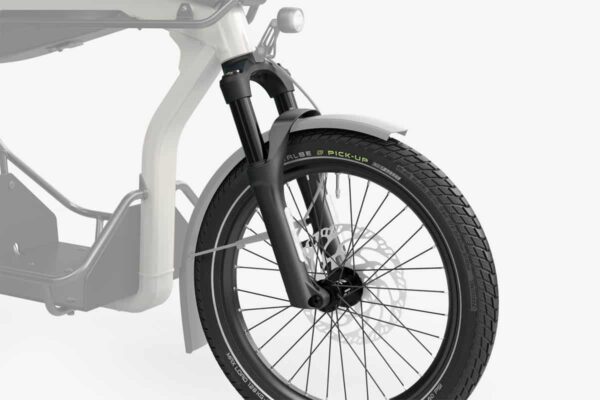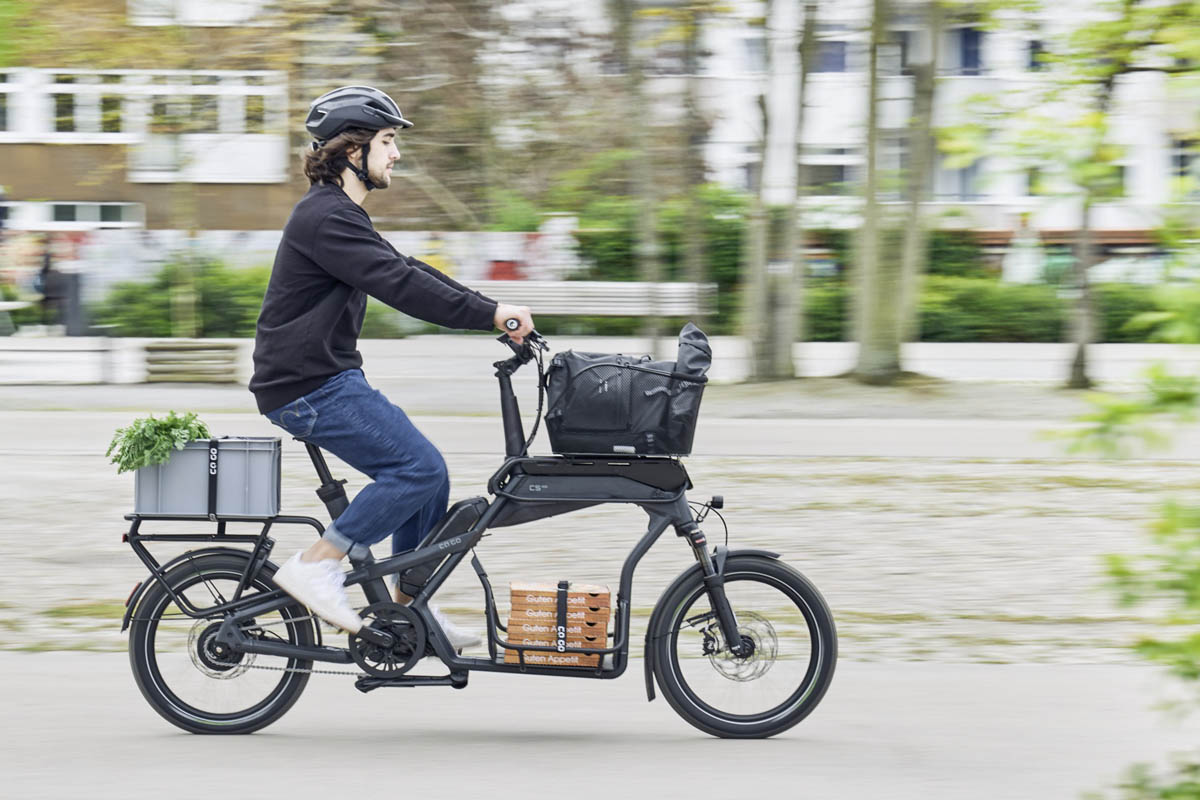They’ve done it again. Once again, another bike hails from Ca Go in Koblenz. And again the manufacturer breaks with established stereotypes and prefers to do it its own way. About two and a half years ago, its Ca Go FS200 impressed with a cargo box made of expanded polypropylene and a hitherto unique quality of workmanship. This time we encounter an ebike that resembles a well-made hiking rucksack with the right storage compartment for every utensil.
Anyone who has ever hiked longer distances with luggage – and perhaps for several days – will know how much science can go into a perfectly packed backpack. So that shoulders and back don’t suffer unduly, the heaviest load should never go all the way to the bottom, left and right sides should be well balanced, things you need to have to hand often should be within easy reach, and so on. The idea behind the new Ca Go CS is basically exactly the same. Stow the heaviest load where it is optimal for the bike’s handling. Have other things within reach. And pack so flexibly that your bike remains nippy, agile and nimble in every situation.
Stable in the centre
Ca Go puts this approach into two letters: CS. The C stands for Centre and the S for Single Track. Central and single-track. Single track is self-explanatory. It is a bicycle with only two wheels. These measure 20 inches in diameter and allow you a tight turning circle, reduce the space requirement of the vehicle, lower the centre of gravity of the cargo and support good pedalling in the narrowness of city centres.
Central, on the other hand, refers to the distribution of the cargo load. With conventional types of cargo bikes, such as a longjohn with the cargo bed in front of the riders or the longtail with the extended and reinforced rear triangle, there is usually a clear centre of gravity: front or rear. Basically, you push the weight in front of you or pull it behind you. The Ca Go CS wants to change this paradigm. How does it do that? Well, by creating a front, a central and a rear cargo area. In the manufacturer’s jargon, the concept is called “Triple Load Space”.

Cargo bike that doesn’t want to be one
The main part of the load is to be carried by the “Center Rack”, i.e. the rear carrier. You can store up to 30 kilograms of weight in the basket, which sits low in the frame between the front wheel and the bottom bracket. The space has been carefully considered. As low as possible. Close to the bottom bracket. This stabilises the handling of the 2.04 metre long bike. The elongated front carrier, the “Front Rack”, can carry 18 kilograms. Its lateral struts and openings allow you to lash down loads. But you can also simply click on bags and baskets that are compatible with the MIK system. The same applies to the rear carrier called “Rear Rack”. There, panniers can also be used as a further transport option. With a maximum load of 27 kilograms, this is also very generously dimensioned. In this way, you can load a total of 75 kilograms and distribute it as best you can.
Given the maximum permitted total weight of 180 kilograms, the Ca Go CS can be called very much an e-cargo bike. Interestingly, Ca Go itself does not use this word even once in the press release accompanying the presentation. Instead, it talks about a City Utility Vehicle (CUV). It combines the “high utility of a cargo bike with the compact design of a conventional bicycle”. In any case, the manufacturer has clearly distinguished the CS from its two Longjohns FS200 Life and FS200 Vario. It measures almost 70 centimetres less in length and 23 centimetres less in width. For some of you, this may not sound like much, but in everyday life it makes an enormous difference in overall handling. Especially since it also weighs about 20 kilograms less.
Adaptable – even for the riders
In terms of dimensions, a Ca Go CS is thus somewhat larger than a typical city ebike. In length, this adds about 20 to 25 centimetres. The weight is also slightly higher. Without cargo and with only one battery, the bike weighs around 35 kilograms. Ca Go has designed the aluminium frame to be one size fits all. It is supposed to be suitable for people with a body length of 1.65 metres to 2.00 metres. You can adjust the stem between -20 degrees and +40 degrees for a better fit. The seat angle is very flat at 65 degrees. It ensures that the distance between the saddle and the handlebars is noticeably increased when the saddle is lifted. This not only offers taller people more space for their legs, but also takes into account the great length of the upper body.

Going for the tried and tested
As far as the actual riding experience is concerned, we have to remain indebted for the moment. Hopefully, the upcoming Eurobike in Frankfurt will provide the opportunity for a test ride. However, the Ca Go CS should handle extremely well. The reason for this assumption is the fact that Ca Go is once again using a redundant cable steering system. We already know this from the FS200. And there it absolutely convinced us. Completely encapsulated and integrated in the frame, wind and weather cannot harm it even in the long term. But we didn’t expect anything else from Ca Go.
The innovative urban ebike is powered by the Smart System version of the Bosch Cargo Line. The power values of the motor are on par with those of the Performance Line CX. The most important distinguishing feature is the special cargo mode, which only this unit features. Ca Go comes with the Bosch PowerPack 545 as a standard battery pack. It is easily accessible on the down tube and, as usual, can be easily removed and charged anywhere. If you want, you can switch to the bigger brother, the PowerPack 725. For a corresponding surcharge, of course.
Three models and a few question marks
A display is only available if you opt for the most expensive of the three available models. It is called the CS200 and costs 6,490 euros. In addition to the Kiox 300, you also get a manual but stepless hub gear from Enviolo in combination with the low-maintenance Gates carbon belt. The choice of gears is a little surprising. For a bike of this type, we would have rather expected the heavy-duty version of the Enviolo gears. This is designed for even greater loads and potentially promises greater stability on this particular bike than the trekking version.
In addition, there is a feature exclusive to the Ca Go CS200 that we would have expected to find on all three models – the rear carrier. As part of the “Triple Load Space”, it could have been part of every model from the start. As it is, however, the Ca Go CS150 and Ca Go CS100 only have a “dual load space”. As mentioned, the operation of the e-drive is limited to the LED Remote and the Bosch eBike Flow App, which is part of the Smart System. In the case of the CS150, the hub gears from Enviolo remain. The total package costs 5,990 euros. The entry-level model, the CS100, has a nine-speed derailleur from Microshift. The price starts at 5,590 euros.
Despite the slight disillusionment at the end, our curiosity to go for a ride on the bike as soon as possible clearly prevails. Although CUV doesn’t come easily to our lips yet. But maybe it will come.
Ca Go CS at a glance
- Variants: CS200, CS150 CS100
- Frame: Aluminium
- Suspension fork: SR Suntour Cargo 20″ Mobie34
- Motor: Bosch Cargo Line Smart System
- Battery: Bosch PowerPack 545
- Display: Bosch Kiox 300
- Control unit: Bosch LED Remote
- Drivetrain: Enviolo CVP Trekking, Microshift Advent H-Series
- Brakes: Magura MT5 (front), Magura MT4 (rear)
- Weight: from 35.5 kg
- Maximum load front rack: 18 kg
- Maximum load center rack: 30 kg
- Maximum load rear rack: 27 kg
- Maximum permitted total weight: 180 kg
- Colours: Active Mint Blue, Black Grey, Silk Grey
- Prices: from 5,590 euros
Pictures: Ca Go Bike GmbH












